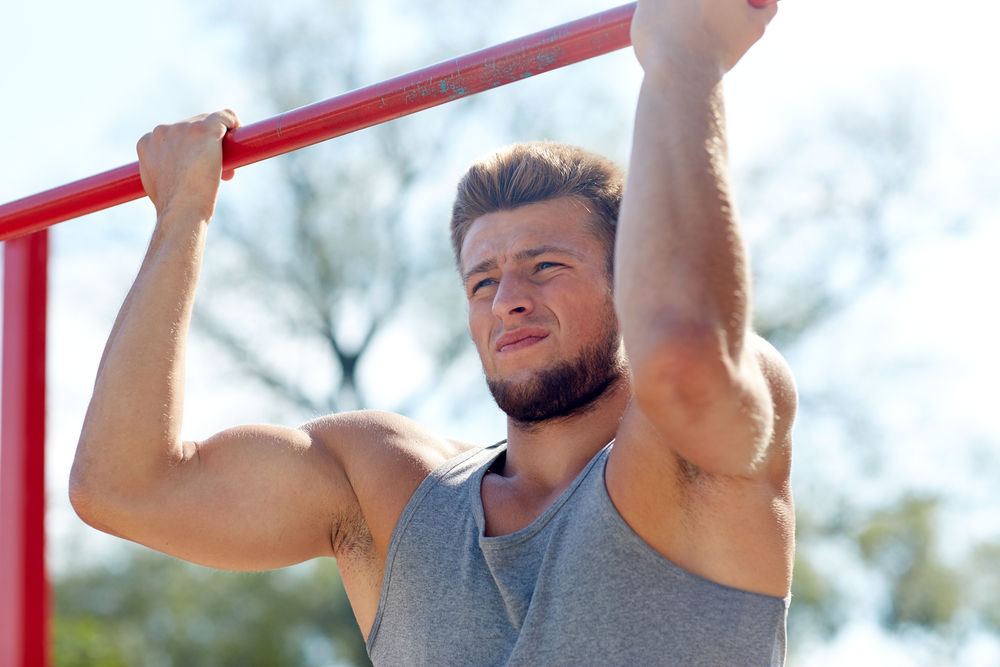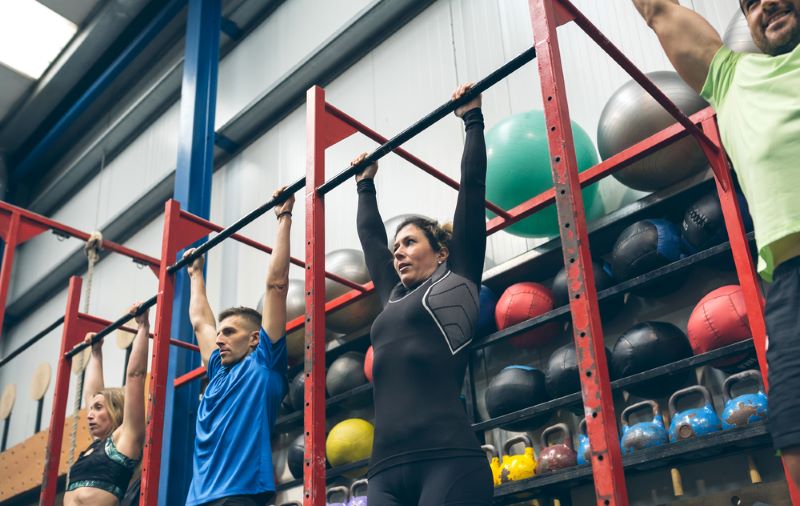Chin-ups and pull-ups may look similar but they’re completely different exercises.
The change from a palms-up grip used in chin-ups, to the palms-down grip used in pull-ups activates different muscle groups and targets different areas of your upper body.
You may be trying to build and develop specific muscle groups in your upper body. If so, you may decide that pull-ups will be better suited to your fitness goals.
However, you may not be very good at pull-ups.
If you can do chin-ups though, you might be wondering whether chin-ups can help improve your pull-ups.
Well, that’s exactly what we’re looking at in this article.
In it, we discuss whether you can use chin-ups to get better at pull-ups, the muscles being worked, as well as some other useful information surrounding the similarities and differences between these two exercises.

Do Chin-Ups Help Improve Pull-Ups?
Yes, chin-ups help improve pull-ups.
Although similar muscle groups are activated during both chin-ups and pull-ups, the focus of each exercise is different.
Chin-ups are easier than pull-ups, so most people can do more of them.
As they work similar muscle groups, you’ll get stronger in the muscles you need to do pull-ups by doing chin-ups.
As you increase the frequency and intensity of your chin-ups, the muscles needed to do pull-ups successfully will develop and increase in strength.
Once you’ve developed the working muscles enough through chin-ups, you’ll likely find that pull-ups become much easier and you’ll be able to complete them more often and with more reps.
Why Chin-Ups Help Improve Pull-Ups
They Build Strength And Endurance In Muscles Needed For Pull-Ups
Although chin-ups put a lot of focus on your biceps, shoulders, and chest, they can actually add good levels of strength and endurance to the working muscles used in pull-ups too.
Although your lats play a big role in pull-ups, they don’t in chin-ups, so it’s understandable why you might think that chin-ups won’t help pull-ups.
However, the key thing to remember is that there are many muscles working during pull-ups.
Most of these are also working during chin-ups.
Your shoulders, some back muscles, arms, and your abs work hard in chin-ups and pull-ups.
Even though your lats aren’t necessarily getting stronger during chin-ups, several muscles around them are which can help assist during pull-ups as your lats then get stronger as a result.
Grip Strength Improves
Without a strong and secure grip, pull-ups will be almost impossible to perform.
Most people find the underhand grip used in chin-ups quite a bit easier than the overhand grip used in pull-ups.
Despite being a bit easier, your grip strength is still likely to improve during chin-ups.
This increase in grip strength can go a long way in making pull-ups easier and more comfortable to perform.
Do Negative Chin-Ups Help Improve Pull-Ups?
Negative chin-ups use the same muscles as standard chin-ups, but the emphasis is placed on the lowering phase of the movement.
In the same way that normal chin-ups can help improve pull-ups, negative chin-ups can help build strength in the muscles used to lower your body down in the second half of the movement.
Both chin-ups and negative chin-ups can help you make some good progress in your pull-ups.
How To Do Chin-Ups To Help Improve Pull-Ups
The key to getting better at pull-ups is consistency.
If you want to use chin-ups to improve your pull-ups, then you should be doing them on a regular basis with strict technique.
Doing chin-ups a couple of times a week with a strong focus on your technique can help improve your pull-ups in a big way.
During chin-ups, your lats won’t be working anywhere near as hard as they would be during pull-ups so it’s important to ensure the other muscles involved in pull-ups are working effectively.
Making sure your hands are in the right position to allow your shoulders to activate, keeping your body stable by engaging your core, and squeezing your shoulder blades at the highest point during chin-ups can all help build strength where you need it for pull-ups.
How Often Should You Do Chin-Ups To Help Improve Pull-Ups?
You usually find that leaving 24 – 48 hours before targeting the same muscle groups again can bring some great results.
If you do chin-ups 2 – 3 times per week, you should see some good gains in strength and endurance while still allowing suitable rest and recovery time too.
As your working muscles recover from chin-ups, their development will help you move towards your pull-up goals.
Do Chin-Ups Work The Same Muscles As Pull-Ups?
Yes, chin-ups work the same muscles as pull-ups.
However, they work the muscles in a different way.
During chin-ups, the main focus is on the muscles at the front of your body such as your biceps and chest. During pull-ups, the main focus is on your lats and lower traps.
The muscles involved in both movements may be the same, but they each have to work to different levels depending on which exercise you’re doing.
Other Ways To Improve Pull-Ups
Dead Hangs

Simply hold on to a pull-up bar with your arms straight and hold that position for as long as you can.
If you do dead hangs with an overhand grip, you’ll be helping to build strength in the grip required for pull-ups.
With grip strength being a big factor in pull-ups, this exercise is a great way of making sure it isn’t an issue for you.
Build A Stronger Back
Having strong back muscles (particularly lats) will make pull-ups much easier to perform.
Developing your back by increasing the intensity or frequency of your back workouts can help build the required strength you need to do pull-ups.
Sources
Pull-Ups & Chin-Ups Muscles Worked
I’ve been in the fitness and strength training industry for nearly a decade. In that time, I’ve gained 30 pounds of muscle, written hundreds of articles, and reviewed dozens of fitness supplements. As for my educational background, I’m a currently studying for my Active IQ Level 3 Diploma in Personal Training.

